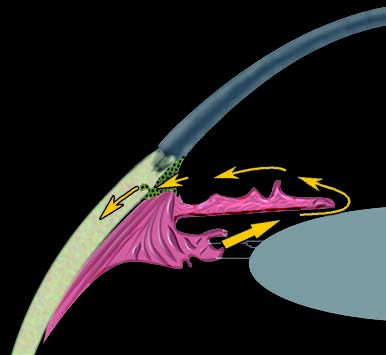Aqueous humor plays a vital role in maintaining the metabolism of ocular tissues, including the lens, vitreous body, cornea, and trabecular meshwork. It provides essential nutrients, such as glucose and amino acids, to sustain their normal functions and removes metabolic waste products, such as lactic acid and pyruvic acid, from these tissues. Additionally, it helps maintain and regulate intraocular pressure, which is critically important for preserving the structural integrity of the eye. Aqueous humor is primarily produced by the ciliary body through active transport (accounting for approximately 75%), ultrafiltration, and diffusion, with a production rate of 1.5–3 µl/min. Due to the presence of the blood-aqueous barrier formed by the ciliary epithelial cells, the aqueous humor is devoid of blood cells and contains only trace amounts of protein. This transparency contributes to its role as part of the refractive medium in the optical pathway. Disruption of the blood-aqueous barrier leads to a significant increase in protein content in the aqueous humor, thereby impairing visual function.
Aqueous humor contains lactic acid, vitamin C, glucose, inositol, glutathione, urea, and electrolytes such as sodium, potassium, and chloride. Protein levels are minimal, at only 0.2 mg/ml. In addition to these components, the aqueous humor contains certain growth regulatory factors, including transforming growth factor-beta 1 (TGF-β1), transforming growth factor-beta 2 (TGF-β2), acidic fibroblast growth factor (aFGF), and basic fibroblast growth factor (bFGF). The partial pressure of oxygen in the aqueous humor is approximately 55 mmHg, while the partial pressure of carbon dioxide ranges from 40 to 60 mmHg. Its pH is around 7.5–7.6. The outflow facility of aqueous humor is between 0.22 and 0.28 µl/(min·mmHg).

Figure 1 Schematic representation of the primary pathway of aqueous humor circulation
The circulation pathway of aqueous humor begins with its production in the ciliary body. From there, it enters the posterior chamber and flows through the pupil into the anterior chamber. It exits the eye via the trabecular meshwork in the anterior chamber angle and drains into Schlemm's canal. It then flows through collector channels and aqueous veins before entering episcleral veins on the scleral surface, ultimately returning to the systemic circulation. A smaller proportion of aqueous humor (approximately 10%–20%) is drained through the uveoscleral pathway in the ciliary band of the anterior chamber angle, while about 5% is absorbed through crypts on the surface of the iris.